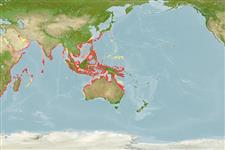>
Pleuronectiformes (Flatfishes) >
Cynoglossidae (Tonguefishes) > Cynoglossinae
Etymology: Paraplagusia: Greek, para = the side of + Greek, plagos, plagios = oblique.
More on author: Bloch.
Environment: milieu / climate zone / Tiefenbereich / distribution range
Ökologie
seewasser; brackwasser demersal; tiefenbereich 1 - 25 m (Ref. 30573). Tropical; 33°N - 32°S, 30°E - 154°E
Indo-Pacific: Red Sea and east coast of Africa to the Philippines, north to southern Japan, south to New Guinea and northeastern Australia.
Size / Gewicht / Alter
Geschlechtsreife: Lm ? range ? - ? cm
Max length : 31.6 cm TL Männchen/unbestimmt; (Ref. 94837); common length : 25.0 cm TL Männchen/unbestimmt; (Ref. 30573)
Rückenflossenstacheln (insgesamt) : 0; Rückenflossenweichstrahlen (insgesamt) : 99 - 115; Afterflossenstacheln: 0; Afterflossenweichstrahlen: 72 - 89; Wirbelzahl: 50. Upper side tan, marbled with dark wavy lines enclosing pale patches; 2 lateral lines on eyed side, none on blind side (Ref. 4418). Caudal vertebrae 36-44; mid-lateral line scales 75-109 (Ref. 9224, 11691).
Body shape (shape guide): short and / or deep.
Found on mud and sand bottoms of the continental shelf (Ref. 30573). Enters shallow estuarine waters (Ref. 4833) and tidal rivers (Ref. 1479).
Life cycle and mating behavior
Geschlechtsreife | Fortpflanzung | Ablaichen | Eier | Fecundity | Larven
Masuda, H., K. Amaoka, C. Araga, T. Uyeno and T. Yoshino, 1984. The fishes of the Japanese Archipelago. Vol. 1. Tokai University Press, Tokyo, Japan. 437 p. (text). (Ref. 559)
IUCN Rote Liste Status (Ref. 130435: Version 2025-1)
Bedrohung für Menschen
Harmless
Nutzung durch Menschen
Fischereien: weniger kommerziell
Tools
Zusatzinformationen
Download XML
Internet Quellen
Estimates based on models
Preferred temperature (Ref.
123201): 25 - 29.2, mean 28.5 °C (based on 2940 cells).
Phylogenetic diversity index (Ref.
82804): PD
50 = 0.5156 [Uniqueness, from 0.5 = low to 2.0 = high].
Bayesian length-weight: a=0.00933 (0.00474 - 0.01837), b=3.03 (2.85 - 3.21), in cm total length, based on LWR estimates for this species & (Sub)family-body (Ref.
93245).
Trophic level (Ref.
69278): 3.5 ±0.4 se; based on size and trophs of closest relatives
Widerstandsfähigkeit (Ref.
120179): hoch, Verdopplung der Population dauert weniger als 15 Monate. (Preliminary K or Fecundity.).
Fishing Vulnerability (Ref.
59153): Low vulnerability (22 of 100).
🛈
